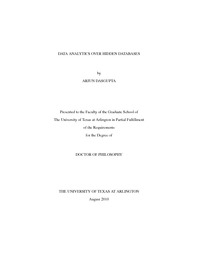
ATTENTION: The works hosted here are being migrated to a new repository that will consolidate resources, improve discoverability, and better show UTA's research impact on the global community. We will update authors as the migration progresses. Please see MavMatrix for more information.
Show simple item record
| dc.contributor.author | Dasgupta, Arjun | en_US |
| dc.date.accessioned | 2010-11-01T21:29:06Z | |
| dc.date.available | 2010-11-01T21:29:06Z | |
| dc.date.issued | 2010-11-01 | |
| dc.date.submitted | January 2010 | en_US |
| dc.identifier.other | DISS-10800 | en_US |
| dc.identifier.uri | http://hdl.handle.net/10106/5170 | |
| dc.description.abstract | Web based access to databases have become a popular method of datadelivery. A multitude of websites provides access to their proprietary datathrough web forms. In order to view this data, customers use the web forminterface and pose queries on the underlying database. These queries areexecuted and a resulting set of tuples (usually the top-k ones) is served to thecustomer. Top-k along with strict limits on querying are constraints used by thedatabase providers to conserve the power of the underlying data distribution.Delivering limited access only to tuples that satisfy a query enables providers toexpose only a small snippet of the entire inventory at a time. This method of datadelivery prevents analysts from deriving information on the holistic nature of data.Analytical queries on the data statistics are hence blocked through these accessrestrictions. The objective of this work is to provide detailed approaches that obtain resultstowards inferring statistical information on such hidden databases, using theirpublicly available front-end forms. To this end, we first explore the problem ofrandom sampling of tuples from hidden databases. Samples representing theunderlying data open up a proprietary database to a plethora of opportunities bygiving external parties a glimpse into the holistic aspects of the data. Analystscan use samples to pose aggregate queries and gain information on the natureand quality of data. In addition to sampling, we also present efficient techniquesthat directly produce unbiased estimate of various interesting aggregates. Thesetechniques can be also applied to address the more general problem of sizeestimation of such databases. In light of techniques towards inferring aggregates, we introduce and motivatethe problem of privacy preservation in hidden databases from the data provider'sperspective, where the objective is to preserve the underlying aggregates while serving legitimate customers with answers to their form-based queries. | en_US |
| dc.description.sponsorship | Das, Gautam | en_US |
| dc.language.iso | en | en_US |
| dc.publisher | Computer Science & Engineering | en_US |
| dc.title | Data Analytics Over Hidden Databases | en_US |
| dc.type | Ph.D. | en_US |
| dc.contributor.committeeChair | Das, Gautam | en_US |
| dc.degree.department | Computer Science & Engineering | en_US |
| dc.degree.discipline | Computer Science & Engineering | en_US |
| dc.degree.grantor | University of Texas at Arlington | en_US |
| dc.degree.level | doctoral | en_US |
| dc.degree.name | Ph.D. | en_US |
Files in this item
- Name:
- Dasgupta_uta_2502D_10800.pdf
- Size:
- 5.551Mb
- Format:
- PDF
This item appears in the following Collection(s)
Show simple item record


